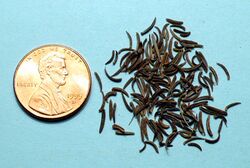Biology:Elwendia persica
| Elwendia persica | |
|---|---|

| |
| Scientific classification | |
| Kingdom: | Plantae |
| Clade: | Tracheophytes |
| Clade: | Angiosperms |
| Clade: | Eudicots |
| Clade: | Asterids |
| Order: | Apiales |
| Family: | Apiaceae |
| Genus: | Elwendia |
| Species: | E. persica
|
| Binomial name | |
| Elwendia persica (Boiss.) Pimenov & Kljuykov
| |
| Synonyms | |
| |
Elwendia persica is a plant species in the family Apiaceae.[1][2] It is related to cumin (Cuminum cyminum) and sometimes called black cumin,[citation needed] blackseed,[citation needed] or black caraway,[3] and has a smoky, earthy taste. It is often confused with Nigella sativa (which is also called black cumin, black caraway, or black seed[4][5]), by which it is often substituted in cooking.
Dried E. persica fruits are used as a culinary spice in northern India , Pakistan , Bangladesh, Afghanistan, Tajikistan, and Iran. It is practically unknown outside these areas.[citation needed]
Etymology
Local names for that spice are kala zeera (काला ज़ीरा black cumin) or shahi zeera (शाहि ज़ीरा; imperial cumin) in Hindi, as syah zirah (سیاہ زیرہ; black cumin), kaala zirah (کالا زیرہ; black cumin), and zirah kuhi (زيره كوهی; mountain/wild cumin) in Urdu, zireh kuhi (زيره كوهی; wild cumin) in Persian, and siyoh dona (сиёх дона; black seed) in Tajiki, and in Malayalam sahajīrakaṁ (സഹജീരകം).[citation needed]
The commonly used Hindi term shahi zeera may be a distortion of syahi (black in Persian) zeera. However, in the Hindustani language, the term syahi also means "inky black". In Bengali, kalo zeera also means black cumin, but refers to Nigella, not E. persica. Nigella is widely used as a spice in Bengali food.[citation needed]
Uses
The plant bears slender, elongate, ribbed fruits which are harvested once the plant has become very dry. Not more than 5 to 8 g can be plucked from each plant, contributing to their high price.
The seeds are most valued as a garnish to high value, very special Indian dishes; they should not be ground, as their flavour would be reduced.
References
- ↑ "Elwendia persica (Boiss.) Pimenov & Kljuykov". The Trustees of the Royal Botanic Gardens, Kew. n.d.. https://powo.science.kew.org/taxon/urn:lsid:ipni.org:names:77128917-1.
- ↑ "Elwendia persica (Boiss.) Pimenov & Kljuykov". GBIF Secretariat. n.d.. https://www.gbif.org/species/8187284.
- ↑ {{citation | mode = cs1 | title = Bunium persicum | work = Germplasm Resources Information Network (GRIN) | url = https://npgsweb.ars-grin.gov/gringlobal/taxonomydetail.aspx?406659 | publisher = [[Organization:Agricultural Research ServAgricultural Research Service (ARS), United States Department of Agriculture (USDA) | access-date = 2022-11-28 }}
- ↑ {{citation | mode = cs1 | title = Nigella sativa | work = Germplasm Resources Information Network (GRIN) | url = https://npgsweb.ars-grin.gov/gringlobal/taxonomydetail.aspx?25337 | publisher = [[Organization:Agricultural Research ServAgricultural Research Service (ARS), United States Department of Agriculture (USDA) | access-date = 2022-11-28 }}
- ↑ "Black seed". https://www.webmd.com/vitamins/ai/ingredientmono-901/black-seed.
External links
Wikidata ☰ {{{from}}} entry
 |


